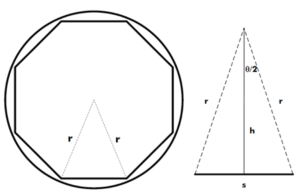Most commonly available parachutes are in fact created from standard two-dimensional flat geometric figures, such as hexagons or octagons.
The figure to the right shows a sketch of a plat parachute which consists of 8 equal triangles.
Hence the total area for the parachute would be
,
where the area of one triangle is
.
By combining these two equations we get
.
You can read more about how to calculate the area of a flat parachute here.
As soon as you know the total area () together with the drag coefficient (
) you can easily determine the descent rate for your CanSat.
If you do not know the drag coefficient for your parachute, you can do drop tests of the CanSat to find the terminal velocity.

